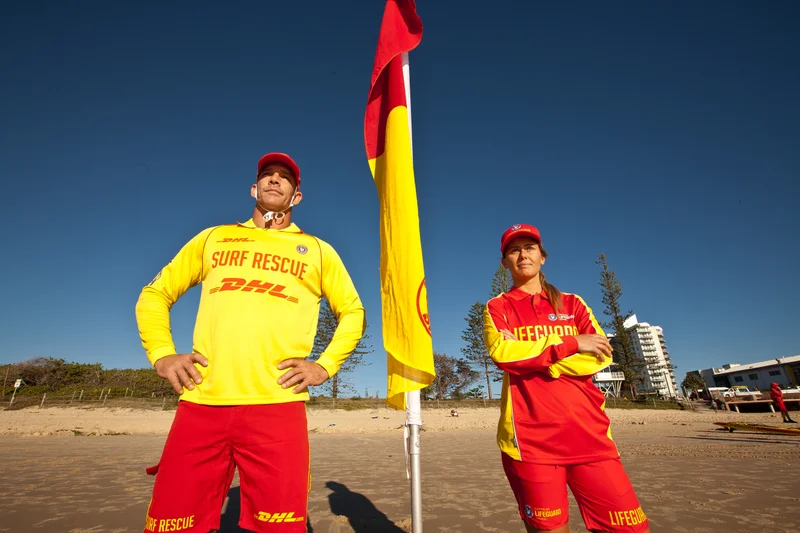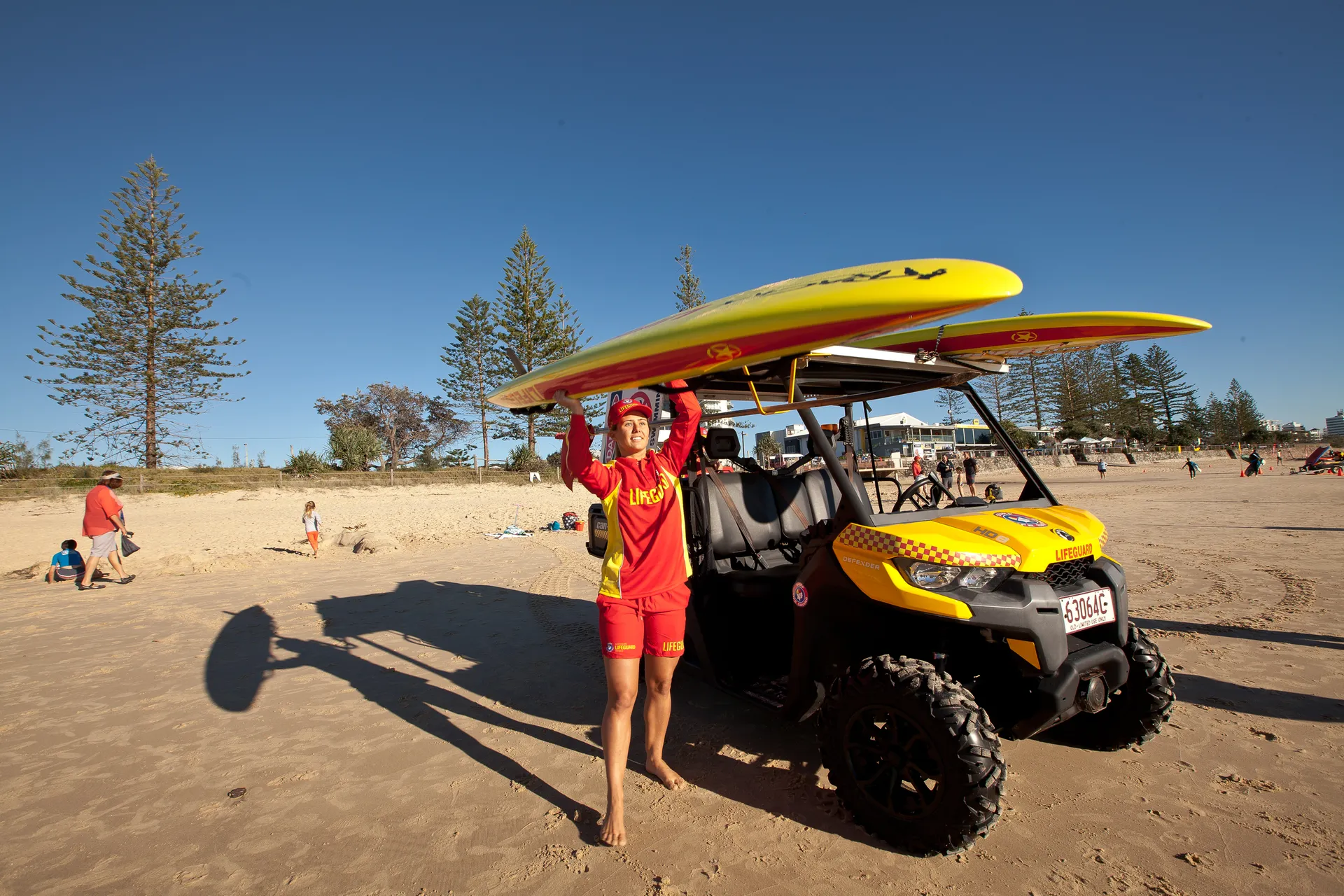The four words that could save your life
As the days get warmer, many locals and visitors just can’t wait to get to the beach and hit the surf… it’s such an exciting and exhilarating experience. However, in the rush to cool off or take a relaxing dip, we can miss signs that, unfortunately, put us at risk.

Following a heartbreaking season last summer that saw three drowning deaths on the Sunshine Coast, lifeguards and volunteer lifesavers are urging everyone to make safety a priority.
Their message is clear: Stop, Look and Stay Alive. The national campaign urges people to Stop before they enter the water, Look for the red and yellow flags to swim between and for any signs and warnings, and Stay Alive by assessing whether they have the ability to tackle the prevailing conditions, not going in alone and only entering the water if it’s safe.
Who’s there to help protect you?
Sunshine Coast Council-funded professional lifeguards, supported by thousands of dedicated volunteer lifesavers, patrol our beaches with one shared mission: zero preventable deaths.
Their message is simple but vital: if you’re heading to the beach, choose a patrolled location and swim between the flags.
The 2025-26 volunteer surf lifesaving season begins on Friday, September 19, in time for the school holidays, and will run until early May 2026.
Last financial year (2024–25), more than 6.6 million people visited Sunshine Coast beaches, with lifeguards and lifesavers performing 550 rescues, 98,574 preventative actions and 7,696 first aid treatments.

How your Council helps save lives
Sunshine Coast Council’s $7.2 million annual contribution towards lifeguarding services ensures year-round patrol services and vital rescue equipment for our community and visitors to the region.
More than 124 professional lifeguards are employed across permanent, part-time and casual positions to cover 21 patrolled beach locations, from north Coolum to Bulcock Beach in Caloundra.
Sunshine Coast Mayor Rosanna Natoli said the region’s beaches were among the best in the world and a source of great enjoyment for locals and visitors.
However, the ocean was an unpredictable environment and Mayor Natoli encouraged everyone to follow the directions of our expert lifeguards to ensure they stayed safe.
“Our funding helps provide lifeguards with the vital equipment they need to perform their duties, including jet skis, all-terrain vehicles, rescue boards, flags, first aid kits and portable surveillance cameras for high-risk locations,” Mayor Natoli said.
“We all need to play our part though.
“Whether you’re a resident or visitor to our beautiful region, always choose a patrolled beach and swim between the red and yellow flags.
“Follow lifeguard and lifesaver instructions, check conditions before entering the water, and never swim alone.
“These simple actions could save lives – including your own.”
What’s new this season
Several improvements will be made to lifeguard services between Coolum and Caloundra to ensure Sunshine Coast beaches are even safer under the Surf Life Saving Queensland – Sunshine Coast Council Lifeguard Service Plan 2023-2028.
Among the most notable changes is an increase in lifeguard resourcing, including:
- A roving lifeguard will now provide relief across multiple lifeguard service locations north of the Maroochy River, ensuring consistent coverage throughout the day.
- Marcoola will now be covered with a second lifeguard during September, Christmas and Easter school holidays.

Image L to R: Cr Tim Burns, SLSQ Operations Aaron Purchase and Trent Robinson, Cr Maria Suarez, Gerard O'Brien President SLSQ and Tim Ryan President SLSQ - Sunshine Coast Branch
A partnership that benefits beachgoers
Surf Life Saving Queensland Sunshine Coast Regional Operations Manager Aaron Purchase said the organisation valued its strong partnership with Sunshine Coast Council in keeping beachgoers safe.
“We appreciate Council’s continued support, which ensures our lifeguards and volunteer lifesavers have the resources they need to respond quickly and effectively,” Mr Purchase said.
“As volunteer patrols return this weekend, we’re reminding everyone to swim between the red and yellow flags and stay aware of beach conditions.
“Rip currents remain a leading cause of coastal drownings, and regular patrols combined with public vigilance are essential to stay alive.
“It’s important beachgoers stop and assess the conditions, look for safety signs and patrol flags.”
To learn more about the national campaign see Stop. Look. Stay Alive. https://sls.com.au/stoplookstayalive/
Sunshine Coast areas patrolled by lifeguards and lifesavers
Sunshine Coast beaches are patrolled by volunteer lifesavers every weekend and on public holidays from 7am to 5pm during the summer season with extended hours to 6pm through the busy Christmas period. This vital service supports lifeguard patrols which occur year-round.
For more information on patrolled beach locations, times and conditions visit www.beachsafe.org.au.
| Tier | Patrol Hours Range from 7am to 6pm Depending on Beach Location and Season | Areas |
| Tier 1 – Major location | All year. | Kings Beach, Dicky Beach, Mooloolaba Main and Spit, Alexandra Headland, Maroochydore, Twin Waters, Mudjimba, Discovery Beach and Coolum |
| Tier 2 – Seasonal service | Seven days a week between September holidays to May, plus weekends, school and public holidays during winter. | Happy Valley, Bokarina, Buddina/Kawana, Marcoola, Coolum North |
| Tier 3 – Weekend / holiday service | Weekends, school and public holidays all year. | Currimundi |
| Tier 4 – Lower seasonal service | Weekends, school and public holidays from September to May. | Bulcock, Boardwalk (Mount Coolum) and Maroochy River Mouth |
| Tier 5 – Summer holiday service only | School holidays between September to May. | Yaroomba Beach and Kings Beach Pool* |
*November to February
Top tips from Surf Life Saving Australia
Always swim at a patrolled beach and stay between the red and yellow flags.
- Use the BeachSafe App or visit beachsafe.org.au to find patrolled beaches and get up-to-date safety information.
- Keep a close watch on children in, on, and around the water at all times.
- Stay clear of alcohol and drugs when near or in the water.
- Wear a lifejacket when boating, rock fishing, or paddling.
- Check weather and surf conditions before heading out.